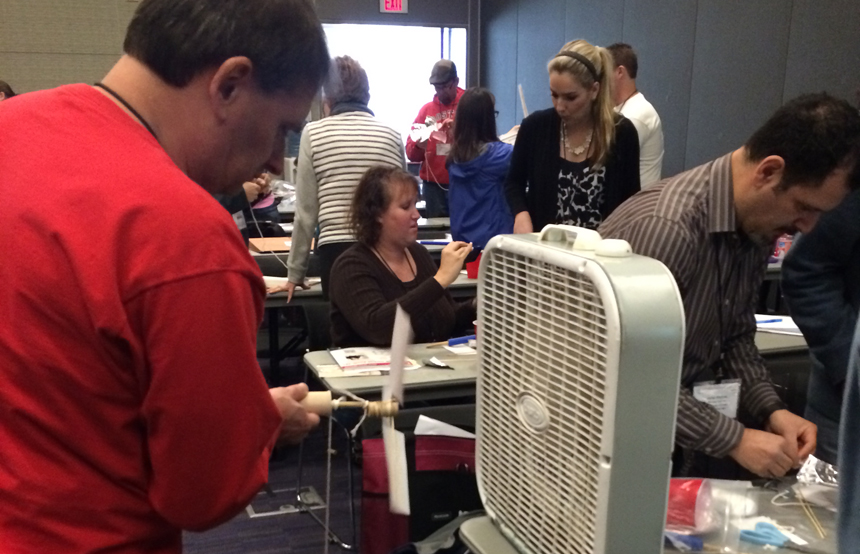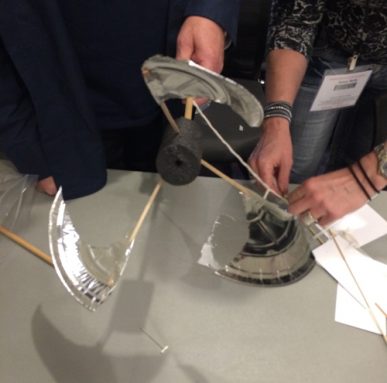Teaching clean energy with the power of wind
KidWind offers teachers resources to help kids understand clean energy

Teachers test out their wind energy designs at a KidWind demonstration.
B. Brookshire/SSP
BOSTON – On a breezy Friday afternoon, some teachers at the annual National Science Teachers Association meeting found themselves sitting before a pile of what looked like junk. Each seat had a plastic bag containing a seemingly random assortment of items. A pie tin, a plastic cup, dowels of various sizes, a cork, string, index cards and pieces of foam. Though the venue was cool, large box fans were placed strategically around the room.
When the room was full, Michael Arquin bounded to the front. A former middle-school teacher, the energetic Arquin is founder and director of KidWind. This company, now based in St. Paul, Minn., provides teaching resources to help kids discover the power of wind. Today, Arquin was here to introduce the teachers to one of the free projects his business has developed: a design-your-own wind-energy machine.
The instructions are deceptively simple: With only the bag of items at your seat and 0.3 meters (one foot) of Scotch tape, build a machine that can turn in the wind. Then adapt the design so that it can lift small metal weights, each about the size of a silver dollar. It doesn’t matter how you design it or which of the provided items you use. “There is no right answer,” Arquin emphasizes.

Pretty soon, the room got windy as the teachers turned on the fans to test their devices. A few designs proved nonstarters, sitting immobile and heavy in the wind. Nearby teachers eagerly offered advice on how to tweak the static device. After most of an hour, many people had nicely spinning blades, and weights went flying as they tried to see how many they could hoist with the power of wind.
All the while, Arquin was up front, answering questions and challenging the teachers to do more with their devices. He explained that as students build a wind-energy machine in the classroom, they begin to understand how they work, what parts are necessary, and how isolating one variable at a time can help them improve their designs. Arquin also noted that teachers can use the exercise for further instruction. They might calculate the work their wind-energy machines are capable of. With that knowledge and a tally of the price of the parts, students can calculate which devices produce the most power for the buck. It’s a critical calculation when dealing with energy in the modern world.
The day’s winning design lifted 30 small metal weights with little more than wooden dowels and a pie tin. While the results were impressive, the teachers just couldn’t match some student achievements. Arquin reported that the best design he ever saw lifted 48 weights — and was the brainchild of middle-school kids.
Arquin wasn’t always leading workshops like this one. He started out as a sixth-grade teacher in Monterey, Calif. He has always been dedicated to educating kids about clean energy, such as solar power and wind.
“I used to do a lot of solar-energy projects with my kids,” he says, “and I wanted to do wind energy. But I couldn’t find any experiments that I liked. So I just started developing things on my own.” Arquin did most of his idea development during a teaching fellowship at the Wright Center for Science Education, then at Tufts University in Medford, Mass. In 2002, he started KidWind out of the basement of his house.
Now, he runs a profitable business that provides information about wind and wind energy, free educational resources and project ideas for the classroom, and free training workshops for teachers to help them best utilize KidWind’s materials. His company’s site also sponsors wind-power competitions and an online store where anyone can buy wind-energy kits, parts, generators and circuit boards to measure the power output of wind, sun, and water.
While teachers and students alike are welcome to buy wind kits, the experiment that Arquin demonstrated shows that you don’t need to spend a lot of money. Instead, you can download free directions from the site and have your students build their own wind-energy machines. With plastic cups, dowels, foam and pie plates, you too can teach students about the power of wind, all the while giving them a chance to discover and invent.
Power Words
solar Having to do with the sun, including the light and energy it gives off.
solar cell A device that converts solar energy to electricity.
wind turbine A wind-powered device — similar to the type used to mill grain (windmills) long ago — used to generate electricity.
Follow Eureka! Lab on Twitter: @Eureka_Labs